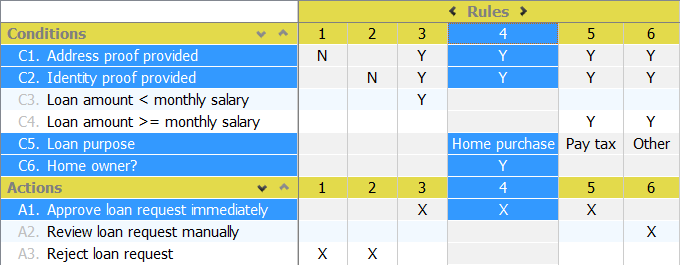What is a Decision Table?
A decision table is a visual representation of a set of rules that can be used to make decisions. It's a grid that shows all the possible combinations of input conditions and the corresponding actions or outcomes. Decision tables are easy to read and understand, which makes them an ideal tool for aligning business goals and business logic.
Case Study - Loan Company
As the property market continues to recover, HPYLoan, a loan company, wants to attract more customers who are looking to purchase a home. To do so, they must develop an effective loan policy that aligns with their business goals.

To achieve this, HPYLoan has created a decision table that outlines their current loan approval policy and identifies areas for improvement. By examining the fourth business rule in the table, they found that requiring a manual review process for home purchasing loans could deter potential applicants.

By studying the forth business rule in the decision table, you can see that if a loan applicant wants to get a loan for home purchasing, it requires a manual review process, which may discourage him/her from applying a loan.
To address this issue, HPYLoan has modified their business rules. They have decided to approve loan requests for home purchasing if the applicant is a current home owner, without the need for further manual review. This change is expected to speed up the loan approval process and make it more attractive for home owners who are looking to purchase a new home.

The final step for HPYLoan is to announce and promote the new policy. By aligning their business goals with their loan policy and utilizing decision tables, they have made an important step towards attracting more customers and growing their business.
Try it out
- Download the decision table sample project.
- Start Visual Paradigm and open the downloaded project file.
- Open the decision table.

- Press on the column header of rule 4.
 By studying the Actions compartment, you can see that if a loan applicant wants to get a loan for home purchasing, it requires a manual review process.
By studying the Actions compartment, you can see that if a loan applicant wants to get a loan for home purchasing, it requires a manual review process.
- Let's modify the rule to that if the loan purpose is for home purchasing and if the loan applicant is currently a home owner, the request can be approved directly without further reviewing. To do this, we need to add a condition to determine if the applicant is a home owner. Move the mouse pointer over the compartment caption Conditions. Click on the add button near the caption.

- Enter Home Owner? as action. Put Y under the forth rule.

- Update the action accordingly. Put Y for the condition Approve loan request immediately and remove the X in Review loan request manually. Finally, the decision table should look like this:

Conclusion
Drafting a policy that aligns with both market needs and business goals can be a long and tedious process without the use of decision tables. Fortunately, decision tables provide a simple and efficient way to analyze and modify business logic.
The tabular layout of a decision table allows you to quickly understand the current rules and easily incorporate new ideas. This makes it easy to confidently make changes to your business logic without fear of unintentionally altering other rules or conditions. With decision tables, you can simplify the process of aligning your business goals with your policies and make adjustments quickly and accurately.


